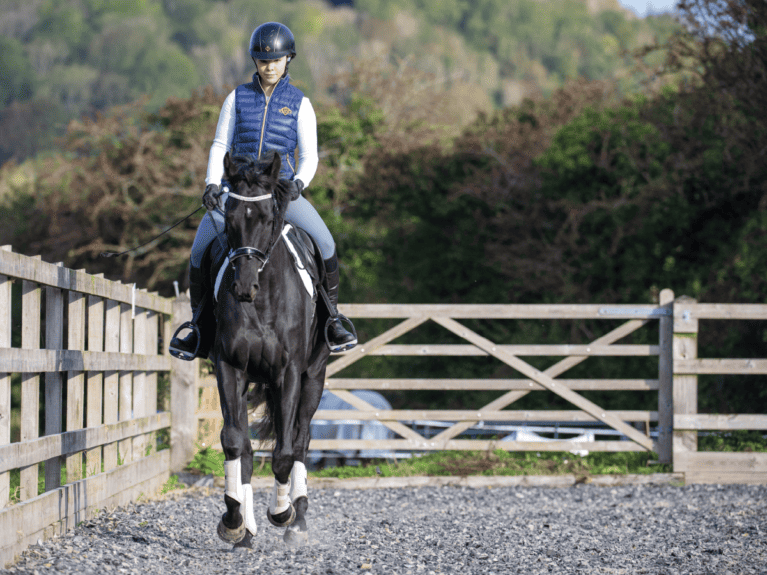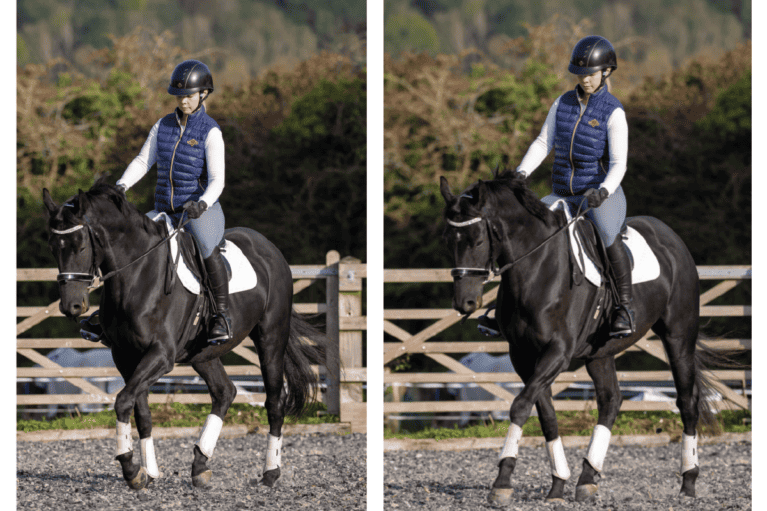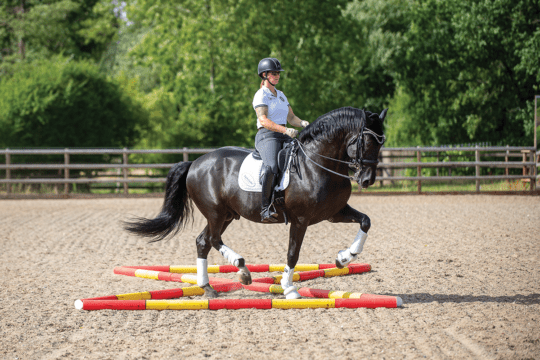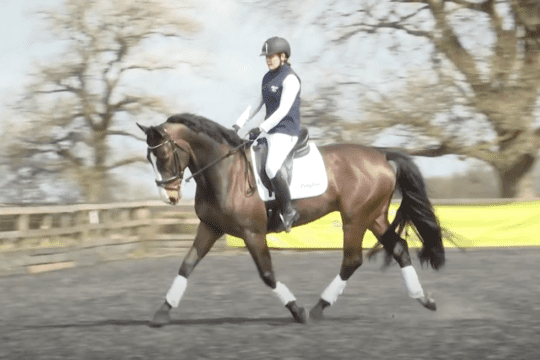There’s no greater feeling than riding a horse who’s travelling freely forward into a soft contact, but how is this achieved? Try our five exercises for starters

Do you struggle to maintain a consistent outline with your horse during schooling sessions? If so, you’re not alone. Young or inexperienced horses may not understand how to stay soft in the rein contact, but more experienced schoolmasters can challenge this concept, too.
A true connection comes from your horse’s hindquarters. By encouraging him to step actively forward from his hindleg you can, in turn, lighten his forehand and encourage him to work in a better outline.
There are lots of exercises that can help, but we’ve picked a handful of our favourites. Why not give them a go next time you ride?
Exercise 1 – Lateral flexion on a circle
Starting in walk…
- Ride a small circle of around 10 metres in one corner of the arena.
- Use your inside leg slightly behind the girth to push your horse’s quarters to the outside of the circle so that the inside hindleg crosses slightly in front of the outside hind
- If all goes to plan, your horse will yield to the rein contact and soften. When this happens, allow the contact forward, encouraging him to stretch down and forward.
- Repeat a few times in each direction
Added benefits
Trains the horse to move away from the rider’s leg, improves suppleness and straightness, teaches the horse to trust the rider’s hands.

Exercise 2 – Riding between collected and extended walk
You can do this on a large circle or in a straight line but either way…
- Start by using some half-halts to ask your horse to take smaller walk steps. Be careful not to lose the activity of the pace as you shorten it up – the rhythm should stay the same.
- As long as your horse stays straight, the collected walk will help to lighten his forehand and engage his hindleg, encouraging softness.
- Once you feel him come lighter in the rein, ask him to take longer steps, towards an extended walk. Keep a contact but allow your hands forward a little more so your horse can lengthen his frame.
- Once he’s stretching down nicely in the extended walk, collect up the walk steps again, repeating the same exercise on both reins a few times.
Added benefits
Strengthens the hindquarters, lightens the forehand, improves your free walk on a long rein.
Exercise 3 – Shadow loops
Start by riding this exercise in walk, until you’re clear about the lines you need to take…
- From one of the corner markers, head away from the track, aiming to reach the three-quarter line when you’re level with E or B.
- As you approach this mid point of the loop, change your horse’s bend so you flex him slightly towards the outside track.
- Then, start heading back towards the next corner marker changing back into inside bend just before you reach it.
- The idea of the exercise is to ride a symmetrical shape with smooth changes of bend. Remember, there are no corners in shallow loops.
- Once you’ve got the hang of the lines, try it in trot, or even canter with a more experienced horse.
Added benefits
Improves suppleness and straightness, introduces the concept of counter-canter, reduces reliance on the track.
Did you know?
Working your horse correctly is the equivalent to a Pilates session. Over time, this creates a stronger core and he’ll have a more flexible spine and topline.
What can go wrong?
An inability to maintain the contact can just be a sign of weakness or inexperience. However, if your horse is struggling to come onto the contact despite a sympathetic schooling routine designed with help from your instructor, have his back, teeth and saddle checked to rule out any physical problems.
Once you’ve had the go-ahead from your horse’s practitioners, it’s worth going through some troubleshooting. If your horse…
- is strong in the contact, try to avoid pulling back. Struggling with control? Then ride plenty of turns, circles and transitions to keep him better balanced
- tucks behind the contact, be sure to maintain a connection with the reins, rather than giving the contact away. Over time you can teach him to accept the contact by riding lots of transitions between the paces and using lateral movements
- sticks his head in the air and refuses to soften whatever you try, why not teach him the idea on the lunge, using loose side reins? Never fit a training aid too tightly – your horse should never be forced into an outline
Exercise 4 – On and back
In working trot to start with…
- Ride a 20m circle at A or C or in the centre of the arena at E or B.
- Ride some quick transitions between medium (longer steps) and collected trot (shorter steps).
- As you ask for the bigger steps, think of riding your horse up towards the sky. Allow slightly with the hand but don’t throw away the contact entirely.
- Continue in the same way until you feel your horse start to lighten in front and soften in the contact.
- Repeat on both reins and, if your horse is balanced enough, try the same exercise in canter.
Added benefits
Strengthens the hindquarters, improves adjustability.

Did you know?
When your horse is working correctly he should be in self-carriage. Test this by giving and retaking the reins for a couple of strides to see if he stays in a good outline, rhythm and balance.
Exercise 5 – Leg-yield on the centre line
- In walk or trot, turn up the centre line at A or C then ride a few steps of leg-yield in one direction.
- Straighten up to prevent your horse from falling through the outside shoulder.
- Leg-yield a few steps in the other direction, towards the centre line.
- Continue until you run out of space.
Added benefits
Teaches the horse to move away from your leg aids, improves suppleness and straightness.
Top tip
Practise leg-yielding movements out hacking where you’re less likely to run out of space and can keep going for longer.















